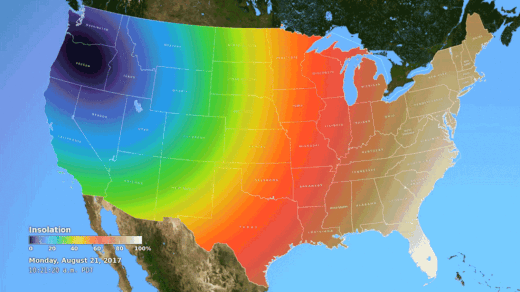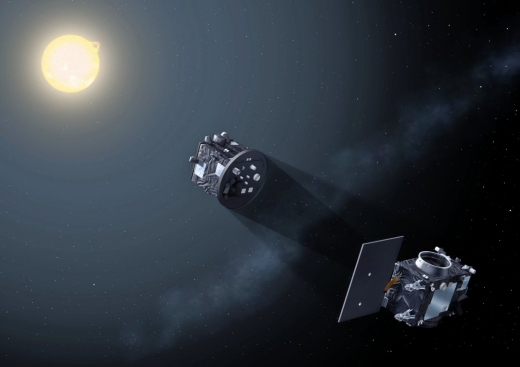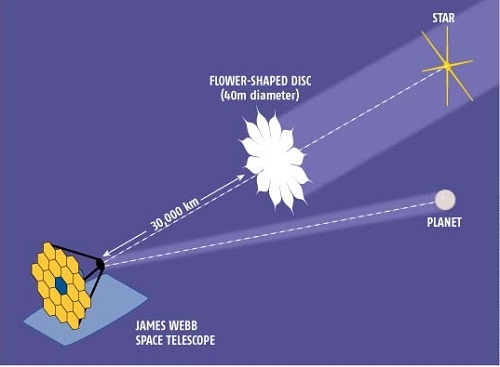Talk about transit depth! Those of you in the path of totality are fortunate indeed as we see just how deep a light curve can get. I’ve never experienced totality and won’t this time, but we’ll get plenty of good science out of this event and a spectacular 160 seconds for those in the path.
As the Sun’s corona is revealed, think about the solar wind — the stream of charged particles flowing from the corona out to the heliosphere — and how we might one day use similar stellar winds to brake the onrush of an interstellar probe with a magsail as it nears destination.

Image: The Moon’s shadow will dramatically affect insolation — the amount of sunlight reaching the ground — during the total solar eclipse. Credit: NASA’s Scientific Visualization Studio
160 seconds of totality is a fleeting but, so I’m told, haunting experience. For scientists, though, we’d like a good bit more. Thus it’s welcome news that the European Space Agency is working on Proba-3, a duo of small satellites designed to interact with each other to block the solar disk over and over again. The camera satellite and disk satellite engage in precision flying, creating artificial eclipses of six hours each time the two craft make one 19.6 hour orbit.
You would think that using a coronagraph to block out the direct light of the Sun would be sufficient, and such techniques are in use both on the ground and in space — the Solar and Heliospheric Observatory (SOHO) has been working with a coronagraph since 1996. But inserting a disk into the instrument to block out sunlight has its limitations. Andrei Zhukov (Royal Observatory of Belgium) is principal investigator for Proba-3’s coronagraph.
“The inner extent of the view afforded by standard coronagraphs is limited by stray light. Stray light is a sort of light pollution inside an instrument. In coronagraphs it is a kind of bending of the sunlight around the blocking disc. This problem can be minimised by extending the coronagraph length, the distance between the camera and the disc, as far as possible – but there are practical limits to coronagraph size. Instead, Proba-3’s coronagraph uses two craft: a camera satellite and a disc satellite. They fly together so precisely that they operate like a single coronagraph, 150 m long.”

Image: Proba-3 satellites form artificial eclipse. Credit: ESA.
Does this kind of precision flying remind you of anything? The use of an occulter craft flying in formation with a second satellite brought the ‘starshade’ concept to mind when I first encountered it. The 150-meter distance between the two Proba-3 craft is much smaller, of course, as 50,000 kilometers separate starshade and telescope in some concepts.
But the idea is similar — to find a way of blocking out the light of a star so as to reveal nearby space. A starshade would give us the opportunity to actually see exoplanets around nearby stars, light which we can then analyze to understand the composition of their atmospheres. In both concepts, the key is precise positioning and maintenance of the geometry through sensors and software. Missions like Proba-3 thus become not only useful scientific probes but likewise early tests of the kind of hardware we will one day use for close-up views of exoplanets.

Image: A starshade blocks out light from the parent star, allowing the exoplanet under scrutiny to be revealed. Credit: University of Colorado/Northrup Grumman.
For more on starshades, see Ashley Baldwin’s WFIRST: The Starshade Option, which looks at how we might use the technology with NASA’s Wide-Field Infrared Survey Telescope. Ponder this: The superb coronagraph that will fly aboard WFIRST will be a thousand times more powerful than anything now in operation, according to an essay by JPL’s Jason Rhodes.
But WFIRST with a starshade could reach contrast ratios 10,000 times greater still. Let me quote Rhodes on the matter:
The Starshade would have to be large, about 25-40 m across for a telescope the size of WFIRST, and even larger for a bigger space telescope that could follow WFIRST, and would fly 30,000-50,000 km away from the telescope. Building a structure that large and doing the precision flying needed to align the telescope and Starshade are no small tasks, but some of our best minds are on it. The peculiar ‘flower with petals’ shape of the Starshade is to deal with the diffraction of light. A circular Starshade would cause some of the star’s light to be bent (via diffraction) directly into the telescope. However, the petals are designed to diffract the light away from the telescope, allowing us to reach that magic 10 billion to 1 contrast ratio.
The artificial eclipses made possible through a starshade are very much on the mind of the astronomical community as the idea matures. So as you enjoy today’s eclipse, consider how critical ‘eclipse science’ will become as we analyze the atmospheres of distant worlds.



“I’ve never experienced totality and won’t this time”
Sorry to hear that. It’s well worthwhile. I saw one many years ago in perfect viewing conditions. Awesome experience. Although I’m not one to go eclipse hunting there will be another nearby opportunity for me some years out in the future.
I’m having difficulty visualizing how a starshade would work for stars that are above or below the orbital plane of the starshade and telescope. Wouldn’t it require a large inclination change (and fuel) and limit the dwell time? Or would a starshade always be “limited” to the stars that can be occulted in the same matching orbit?
Frank, I think you’re right about the problem of inclination change, though I’m not fully clear on how the starshade would be re-positioned — I gather the current NASA concept includes thrusters to allow changing target stars. But how wide a range of sky can be realistically targeted in such a mission is an interesting question. I’ll see if I can get some further thoughts from someone working the problem.
This is covered at length in the NASA Exo-S Probe concept final report available on line.
To briefly summarise the target list is determined by several factors. Firstly whether the mission is ” dedicated ” , I.e a purpose built 1.1 m telescope and 30m starshade launched in tandem . Most likely in an Earth leading orbit ,where the smaller telescope moves to position itself for imaging utilising bipropellant thrusters. The target options depend on the length of the mission from a limited Technological demonstrator 1 year version up to a three year extended survey .
Fuel determines mission length and target selection in all observation options , above or below.
The second main mission is a “Rendezvous” whereby a larger, powered starshade joins the already in place ( at SEL2) WFIRST 2.4m scope ( but with a star shade adaption package) at the end of its primary mission. Again various length missions are possible from a 3 year survey up to a maximum hi-return 5 year mission. Thrust would be bipropellant for the three year mission and SEP for the 5 year, though the latter would involve significant technological development including lightweight solar cells that could be incorporated direct onto the starshade to limit thermomechnical stability issues arising from seperate large solar arrays.
Observation field for all mission options is determined also by the angle of both the starshade and telescope in relation to the Sun. Too high for the star shade ( beyond 126 degrees) and light reflects off its surface inhibiting imaging , and below 54 degrees for the telescope allows damaging sunlight into the 2.4 m telescope . The two angles are correspondingly less for a smaller ” dedicated” telescope and starshade mission.
All mission options assume preselected targets to minimise fuel use , the number fitting within the mission length but in such a way as to maximise repositioning in-between ( I think an verge of 10 days or so ) . The rendezvous mission has the advantage that the telescope can be used for other astrophysics throughout this time ( including exoplanet work if equipped with a coronagraph too ) . Though for many stars should planets have been predetected by RV spectroscopy the orbital inclinations won’t be generally known which will have an effect on detection of for instance hab zone planets which if not seen near edge on may well lie within the 75-85 mas Inner working angles of the Rendezvous and dedicated starshades . Detailed pre-analysis ( mostly by Hubble ) of most stars within the 10-20 parsec observation maximum of the 2.4 m and 1.1m telescopes is hoped to guarantee atleast a 25 % detection ( completion ) rate with the larger telescope on average locating twice as many hab zone terrestrial planets per unit observing time.
I was lucky to live in the path of totality. The partial phases weren’t, honestly, much to write home about, a bit cool, but that’s it.
Totality, OTOH, was the most amazing astronomical phenomenon I’ve ever seen, even seeing the aurora from horizon to horizon back in the 90’s paled by comparison. Even got to see some solar flares with my binoculars!
Didn’t see it this time, but I saw the total eclipse in August 1999, definitely worth seeing one. Would like to see an annular eclipse at some point, maybe the October 2023 eclipse might be feasible to view in person.
I witnessed an annual eclipse sometime back in the mid 90’s. The moon was perfectly aligned leaving a brilliant ring of light when viewed through a welding helmet. However, the sun, to the unshielded eye was way to brilliant to look at. The sky and landscape did darken and the air felt cooler but not nearly as much as one would imagine given the amount of lunar blockage. I was the only person at our machine shop to take the time to go out side for a view. Not awe inspiring.
Paul Gilster: ANOTHER “future” of eclipse science will obviously feature CONCRETE PROOF of whether IRREGULAR eclipses are caused by EITHER natural or non-natural objects. Please read the PDF of the FOLLOWING paper up om http://exoplanet.eu/catalog.php. in the bibliography section: “Likely Transiting Exocomets Detected by Kepler” by Rappaport s., Vanderberg a., Jacobs T., Lacourse D., Jenkins J., et al ASAP!!! As far as I could see(correct me if I am wrong) I DID NOT SEE ONE SINGLE MENTION OF BOYAJIAN’S STAR IN THIS PAPER. I would appreciate it if you would contact them and ask them WHY!!!
They DO mention Boyajian’s Star at the very end of their paper. They pretty much reject the cometary hypothesis.
We saw 82 percent blockage on Skyline Drive in Shenandoah National Park. It was totally whimsical to see the sky become a much darker blue and the much reduced illumination of the ground and surrounding mountains. This got me pondering the perhaps huge number of landscapes and star-shines on habitable extra-solar planets.
EricSECT: I saw your comment: “It just seems common sense that this triplet signature is that of a transiting ringed planet. I know, the large dip is too deep. Call ’em as I see ’em.” on the https://www.reddit.com/r/KIC8462852 website. OK:SUBSTITUTE “…planet…” for ‘mini'(relative, of course)Dyson Sphere, and SUBSTITUTE “…ringed…” for torus CONNECTED to the “mini” Dyson Sphere via spokes. DOES THIS MAKE SENSE TO YOU? I know, no IR excess. Call ’em as I see ’em.
Thanks. As I have previously commented on this website, I ONLY post comments HERE, and occasionally on the “AstroWright” website(my ABOVE idea was posted THERE a few months ago when Biallesteros et al put their paper up on ArXiv), because I do not participate on websites where you have to SUBSCRIBE! I SURE DO VISIT THEM THOUGH! I can’t wait to read the reaction posts on http://www.reddit.com/r/KIC8462852 to the two NEW papers. “Extinction and the Dimming of KIC8462852.” by Meng H., Rieke G., Dubois F., Kennedy G., Merengo M., Siegal M., Boyajian T., et al(HIGHLIGHTS:The FADE is caused by CIRCUMSTELLAR MATERIAL!)AND “Where is the Flux Going?” by Simon J., Shappee B., Pojmonski G., Montet B., Kochanek C., et al(HIGHLIGHTS: Fade CONTINUES at Kepler “rate”, BUT with TWO BRIGHTENING EPISODES)!
Great article Paul. Thanks for the citation too. There is certainly no doubt that starshades offer potential for search and characterisation of Earth mass planets in the habitable zone of sun like stars above and beyond transmission spectroscopy for transiting planets around smaller stars. Unlike integral coronagraphs they aren’t hamstrung by picometer level telescope stability requirements and almost as stringent low and high order wavefront control . They also offer a far larger spectroscopic bandwidth . The downside is that for a telescope of say WFIRST’s 2.4 m aperture , a 30m plus diameter shade ( and suitable satellite bus ) would need to be placed tens of thousands of Kms away and “formation flown ” autonomously to maintain the telescope at a durable point in the umbra for the week/s necessary to complete a characterisation. Such a large shade would need to be deployable in order to fit into even the SLS payload bay . All of this is technologically possible though with varying degrees of uncertainly . Probably certainly represents a good start but the starshade also needs multiple precision engineered diffraction mitigating petals . Difficult to test and deliver to NASA’s Technological Readiness Level, TRL6 minimum standard for varying funding programmes . After all that a 34m shade ( such as NASA’s EXO-S Probe concept) would come in at betwen 6-7 hundred million dollars . On top of the telescope !
To this end D’Amico and McIntish at the Space Rendevous Laboratory at Standford University are looking to develop mDOT, a miniaturised version incorporating a 10 cm cubesat based telescope flying in a high Earth orbit 500 Kms away from a 3m starshade . Cost in the millions and a great way to build towards TRL6. Hopefully persuading NASA to part with the huge outlay for a big enough version to hopefully supplement WFIRST in the late 2020s. Still risky though as telescope and shade would be seperately funded and be entirely dependent on each other as far as exoplanet science goes. But certainly something to watch out for as the technology matures.
Watch: Alaska Airlines flight offers dramatic view of solar eclipse
http://www.seattletimes.com/business/boeing-aerospace/alaska-airlines-flight-offers-dramatic-view-of-solar-eclipse/
Renowned Astronomer Jill Tarter Says Eclipse Reminds Us We’re Earthlings
By Melodie Edwards • 22 hours ago
An award-winning astronomer famous for her search for extraterrestrial intelligence spoke to a sold out audience at the Lander high school the night before the eclipse. Author Carl Sagan based the central character of his novel Contact on Jill Tarter, and the book was also made into a movie with Jodie Foster. Tarter is a fellow at the SETI Institute (Search For Extraterrestrial Intelligence).
Tarter said she’s seen two other total solar eclipses in her life but she chose to see this one in Wyoming because her daughter works for the National Outdoor Leadership School or NOLS in Lander. Tarter’s talk was called “The Solar Eclipse, The Universe and You.”
She said this eclipse was a great way to help Americans see themselves through a broader perspective as earthlings.
“A solar eclipse will change your perspective,” Tarter said. “It just causes you to step back and look at things from a different place. If people can open their minds a bit, what I call a cosmic perspective, it helps to trivialize the differences among people.”
Tarter said she was thrilled to see Americans embrace the eclipse.
Full article here:
http://wyomingpublicmedia.org/post/renowned-astronomer-jill-tarter-says-eclipse-reminds-us-were-earthlings
To quote:
“It seemed to me the opportunity of an eclipse which is such a powerful natural occurrence to be able to interact with,” said Tarter. “It gives an opportunity to talk about the fact that 500 million years from now we won’t have any total solar eclipses anymore. The moon will have moved too far away from the earth.”
Tarter said while 500 million years might seem like a lot, it isn’t from the point of view of the universe and that’s a perspective humanity would benefit from looking through.
Where to see the next solar eclipses through the year 2046:
http://www.atlasobscura.com/articles/upcoming-solar-eclipses-dates-places
I can remember when the one for August 21, 2017 seemed so far away.
Racing the eclipse, backup balloon sends striking video:
https://engineering.vanderbilt.edu/news/2017/racing-the-eclipse-backup-balloon-sends-striking-video/
Another balloon eclipse mission:
https://www.geekwire.com/2017/seattles-space-sisters-get-great-views-learn-lessons-eclipse-balloon-flight/
When the total solar eclipse becomes a truly religious experience:
http://www.vofoundation.org/blog/experiencing-god-totality-reflections-solar-eclipse-stirred-religious-experience/